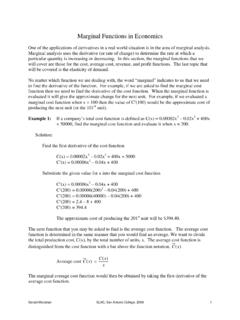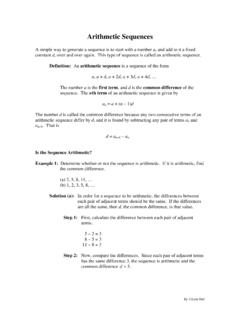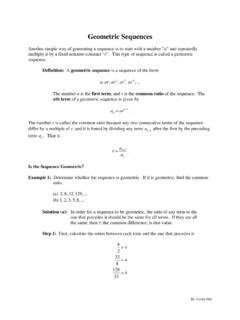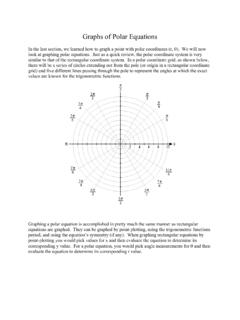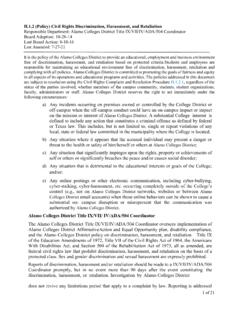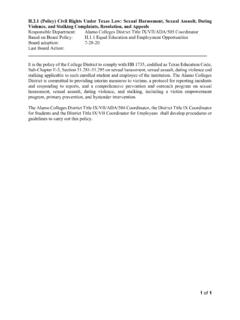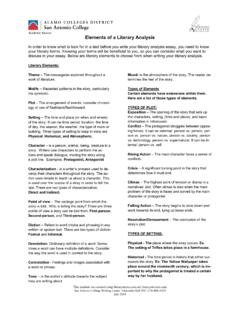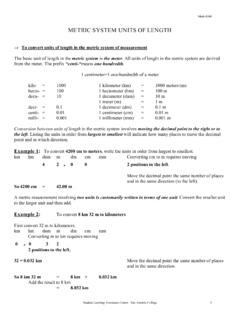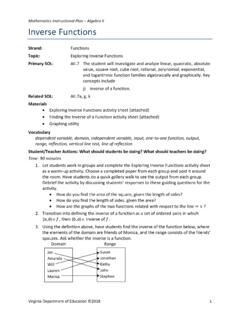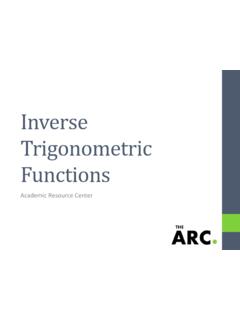Transcription of INVERSE TRIGONOMETRIC FUNCTIONS
1 INVERSE TRIGONOMETRIC FUNCTIONS Review First, let s review briefly INVERSE FUNCTIONS before getting into INVERSE TRIGONOMETRIC FUNCTIONS : f f -1 is the INVERSE The range of f = the domain of f -1, the INVERSE . The domain of f = the range of f -1 the INVERSE . y = f(x) x in the domain of f. x = f -1 (y) y in the domain of f -1 f [f -1 (y)] = y y in the domain of f -1 f -1[f (x)] = x x in the domain of f Trigonometry Without Restrictions TRIGONOMETRIC FUNCTIONS are periodic, therefore each range value is within the limitless domain values (no breaks in between). Since TRIGONOMETRIC FUNCTIONS have no restrictions, there is no INVERSE . With that in mind, in order to have an INVERSE function for trigonometry, we restrict the domain of each function, so that it is one to one.
2 A restricted domain gives an INVERSE function because the graph is one to one and able to pass the horizontal line test. By Shavana Gonzalez Trigonometry With Restrictions How to restrict a domain: Restrict the domain of the sine function, y = sin x, so that it is one to one, and not infinite by setting an interval [- /2, /2] The restricted sine function passes the horizontal line test, therefore it is one to one Each range value (-1 to 1) is within the limited domain (- /2, /2). The restricted sine function benefits the analysis of the INVERSE sine function. INVERSE Sine Function sin -1 or arcsin is the INVERSE of the restricted sine function, y = sin x, [- /2, /2] The equations y = sin -1 x or y = arcsin x which also means, sin y = x, where - /2 < y < /2, -1 < x < 1 (remember f range is f -1 domain and vice versa).
3 Restricted Sine vs. INVERSE Sine As we established before, to have an INVERSE TRIGONOMETRIC function, first we need a restricted function. Once we have the restricted function, we take the points of the graph (range, domain, and origin), then switch the y s with the x s. By Shavana Gonzalez Restricted Sine vs. INVERSE Sine Continued .. For example: These are the coordinates for the restricted sine function. (- /2, -1), (0, 0), ( /2, 1) Reverse the order by switching x with y to achieve an INVERSE sine function. (-1, - /2), (0, 0), (1, /2) By Shavana Gonzalez Sine- INVERSE Sine Identities sin (sin -1 x) = x, where -1< x < 1 Example: sin (sin -1 ) = sin (sin -1 ) (not within the interval or domain of the INVERSE sine function) sin-1 (sin x) = x, where /2 < x < /2 - Example: sin-1[sin ( )] = sin-1[sin (-2)] -2 (not within the interval or domain of the restricted sine function) Without Calculator To attain the value of an INVERSE TRIGONOMETRIC function without using the calculator requires the knowledge of the Circular Points Coordinates, found in Chapter 5, the Wrapping Function section.
4 Here is quadrant I of the Unit Circle The Unit Circle figure shows the coordinates of Key Circular Points. These coordinates assist with the finding of the exact value of an INVERSE TRIGONOMETRIC function. By Shavana Gonzalez Without Calculator Example 1: Find the value for sin -1 (-1/2) Answer: sin -1 (-1/2), is the same as sin y= -1/2, where /2< y < /2 Since the figure displays a mirror image of /6 on the IV quadrant, the answer is: y = - /6 = sin -1 (-1/2) Although sin (11 /6) = -1/2, y must be within the interval [- /2, /2]. Consequently, y= - /6, which is between the interval, meets the conditions for the INVERSE sine function. With Calculator There are different types of brands on calculators, so read the instructions in the user s manual. Make sure to set the calculator on radian mode.
5 If the calculator displays an error, then the values or digits used are not within the domain of the trigonometry function For example: If you punch in sin-1 ( ) on your calculator, the device will state that there is an error because is not within the domain of sin -1. By Shavana Gonzalez Restrict Cosine Function The restriction of a cosine function is similar to the restriction of a sine function. The intervals are [0, ] because within this interval the graph passes the horizontal line test. Each range goes through once as x moves from 0 to . INVERSE Cosine Function Once we have the restricted function, we are able to proceed with defining the INVERSE cosine function, cos -1 or arccos. The INVERSE of the restricted cosine function y= cos x, 0 < x < , is y= cos -1 x and y = arccos x.
6 Which also means, cos y = x, where 0 < y < , -1< x < 1 (Remember, the domain of f is the range of f -1, and vice versa). By Shavana Gonzalez Restricted Cosine vs. INVERSE Cosine The restricted cosine function has the domain, range, and x-intercept coordinates: (0,1) ( /2, 0) ( , -1) The INVERSE cosine function switched the coordinates of the restricted function, x is now y, and y is now x: (1, 0) (0, /2) (-1, ) By Shavana Gonzalez Cosine- INVERSE Cosine Identities cos (cos -1 x) = x, where -1< x < 1 Example: cos (cos -1 ) = cos (cos -1 ) (not within the interval or domain of the INVERSE cosine function) cos-1 (cos x) = x, where 0 < x < - Example: cos-1[cos ( )] = cos-1[cos (-2)] -2 (not within the interval or domain of the restricted cosine function) Cosine INVERSE Solving Without Calculator: Example 2: cos (cos -1 ) Answer.
7 Since -1 < < 1, then cos (cos -1 ) = because the form is following the cosine- INVERSE cosine identities. Example 3: arccos (-1/ 2) Answer: arccos (-1/ 2), is the same as cos y= -1/ 2,where 0< y < . Due to the fact, that the figure displays a mirror image of /4 on the II quadrant, (3 /4), the answer is y= 3 /4 = arccos (-1/ 2). Even though cos (-3 /4) = -1/ 2, y -3 /4. The y must be within the interval [0, ]. By Shavana Gonzalez Solving Cosine INVERSE With Calculator There are different types of brands on calculators, so read the instructions in the user s manual. Make sure to set the calculator on radian mode. If the calculator displays an error, then the values or digits used are not within the domain of the trigonometry function For example: If you punch in cos-1 ( ) on your calculator, the device will state that there is an error because is not within the domain of cos -1.
8 Restriction of Tangent Function To become a one-to-one function, we choose the interval (- /2, - /2), thus a restricted function is formed. The restricted tangent function passes the horizontal line test. Each range value (y) is given exactly once as x proceeds across the restricted domain. Now, that we have the function restricted we will use it to formulize the INVERSE tangent function. By Shavana Gonzalez INVERSE Tangent Function Signified by tan -1 or arctan y= tan -1 or y= arctan x The definition, undifferentiated to sine and cosine, is the INVERSE of the restricted tan function (y= tan x), in the interval - /2 < x < /2 The INVERSE is equivalent to tan y= x, where - /2 < y < /2 Here is the graph of restricted tangent function Here is the graph of INVERSE tangent function The coordinates on the restricted function (- /4, -1), (0, 0), and ( /4, 1) are reversed on the INVERSE function.
9 The vertical asymptotes on the restricted function become horizontal on the INVERSE . By Shavana Gonzalez Tangent- INVERSE Tangent Identities tan (tan -1 x) = x, where - < x < Example: tan (tan -1 2) = 2 tan (tan -1 ) = tan-1 (tan x) = x, where /2 < x < /2 tan-1[tan ( )] = tan-1[tan(-2)] -2 (not within the interval or domain of the restricted tangent function) Solving INVERSE Tangent Problem Without Calculator Example 4: y= tan -1 ( 3) Answer: tan -1 ( 3), is the same as tan y = 3, where - /2 < y < /2. Therefore, y = /3= tan -1 ( 3): Since tan x= b/a = 3/2 = 3/2 2/1 = 3/2 , then the answer to tan -1 ( 3) = y = /3 Example 5: tan [tan -1 (56)] Answer: According to the Tangent- INVERSE Tangent Identities, tan (tan -1 x) = x, where - < x <.
10 Consequently, any number x will equal number x because the domain is infinite, no limits. So, the answer: tan [tan -1 (56)] = 56 By Shavana Gonzalez Summary Let us summarize all the different INVERSE TRIGONOMETRIC FUNCTIONS . y = sin -1 x x = sin y, where -1 < x < 1, and - /2 < y < /2 y = cos -1 x x = cos y, where -1< x <1, and 0 < y < By Shavana Gonzalez Summary Continued .. y = tan -1 x x = tan y, where - < x < , and - /2 < y < /2 By Shavana Gonzalez
